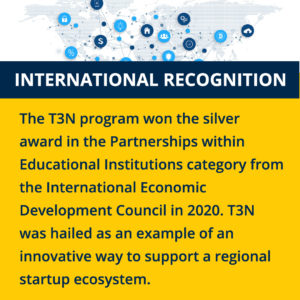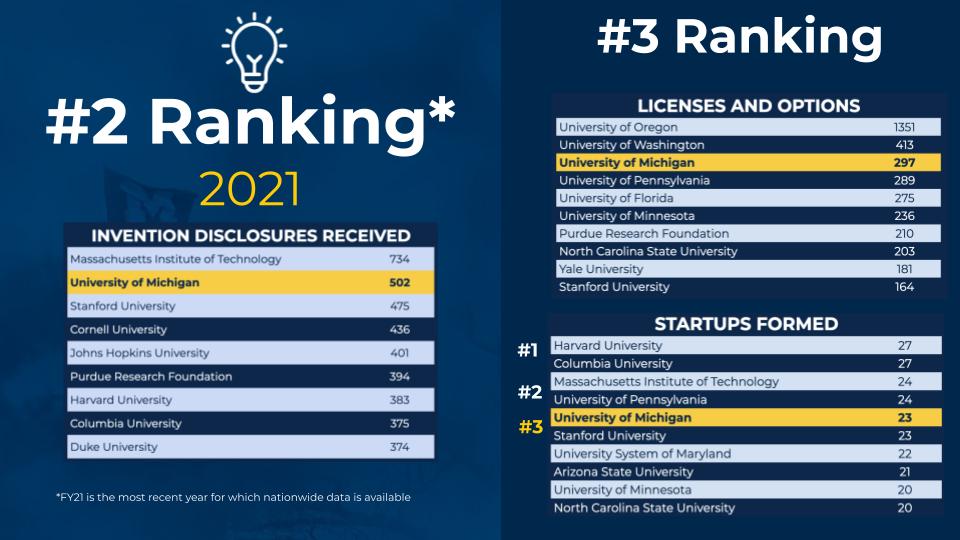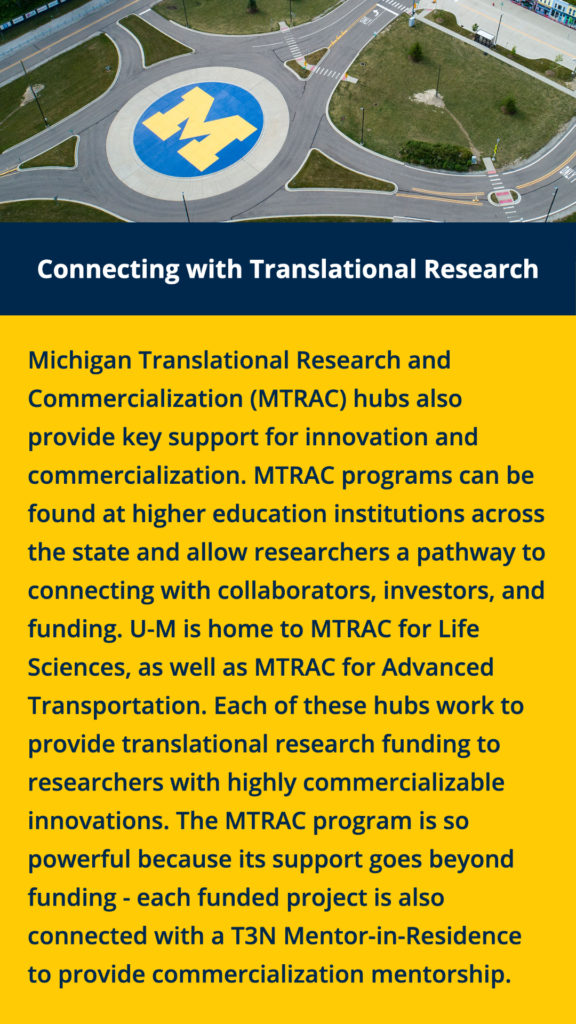How T3N Helps Make Commercialization at Michigan Universities Possible
1/31/2023
The state of Michigan-funded Technology Transfer Talent Network (T3N) removes crucial barriers to commercializing university innovations and growing the local economy. Ten years in, T3N’s impact on those measures is undeniable and the resolve to continue creating opportunity is stronger than ever.
The Technology Transfer Talent Network (T3N) was created in 2012 to enhance the commercialization of university opportunities with talent programs and resources, made possible thanks to funding support from the Michigan Economic Development Corporation (MEDC), the statewide economic development organization for Michigan, matched by each participating university. T3N was conceived by the University of Michigan to share best practices and provide mutual support among six other sister Michigan research universities: Grand Valley State University, Michigan State University, Michigan Technological University, Oakland University, Wayne State University and Western Michigan University.
“If you look at the trend in the last ten years, the number and quality of U-M startups has vastly improved thanks to what the T3N funding makes possible,” said Innovation Partnership’s Mike Psarouthakis, Director of Ventures and Managing Director of the Accelerate Blue Fund. In 2021, U-M ranked third in the country for the number of startups launched according to the AUTM National Survey. Since 2010, U-M has seen a 155% increase in the number of startups formed.
The core component of T3N driving startup formation is the 19–20 mentors-in-residence (MIRs) that the program funds, 11 of which sit at U-M.
“As an academic researcher, you’re not necessarily trained in the business milestones involved in forming a startup,” explained Larry Herriman, University Technology Program Director at the MEDC. This is where MIRs come in. “The key is to get individuals with business experience involved very early on to help the innovators have the theme of commercialization as they are doing their research. That way, when they get to the end, they have something that can be licensed or brought into a startup,” he said.
At Innovation Partnerships, MIRs begin working with innovators on projects that have startup potential early – often before there’s any intellectual property involved. They bring to the university and its innovators a wealth of knowledge that helps faculty fill in business acumen gaps. They also bring connections to investors and to local talent who may become future employees and company leaders.
“The experience MIRs bring is not easily accessible, even in the early stages of a startup, let alone at the ideation stage. That’s especially true in the midwest, where resources are often more limited when compared to the coasts,” said Psarouthakis.
Talent
T3N fosters talent via MIRs in several ways: the MIR position itself provides a local landing spot for experienced people to stay local and contribute to the startup ecosystem; the startups made possible through MIR support provide a source for cultivation of new talent as the companies grow, hire and train new employees; and the Postdoctoral Commercialization Fellowships trains the next generation of entrepreneurial leaders.
“Nine recipients of Postdoctoral Commercialization Fellowships have gone on to found U-M startup companies. These companies have raised over $20M in capital,” said Psarouthakis.
“The experience and stories behind our team are incredible,” said Psarouthakis. Innovation Partnerships has built a team of MIRs who have been there, done that when it comes to successfully navigating both the public and private sectors. The MIRs also have the desire to mentor, an ingredient as important as pedigree for the position’s duties.
Take Innovation Partnerships MIR Meera Vijan, for example, who was responsible for setting up the largest Lithium-ion battery plant in the United States when she was Plant Manager for A123 Systems. She was also President of the Energy Conversion Devices subsidiary, Ovonic Battery Company, and has thirty years of experience in the advanced battery and flat panel display industry.
“The MIR opportunity came across my path and it sounded very interesting. It has allowed me to lend and apply the experience and knowledge I had gained over the years, while keeping me involved and abreast of current developments in industry,” Vijan said about what attracted her to the MIR position.
Bruce Auerbach, another MIR at Innovation Partnerships, echoed the sentiment: “I love being an MIR. Being an MIR at this stage in my life is very fulfilling – not only do I get to engage with the other MIRs and colleagues in Innovation Partnerships, I have the opportunity to continue learning from the world-class researchers that I work with. I never enter into a discussion with a professor without spending hours reading their papers. If I don’t understand what they’re saying, they aren’t going to care what I say.”
Auerbach worked on the preclinical development of what would become Lipitor. While at Pfizer, he also helped shepherd the development of five compounds from early discovery to clinic.
After Pfizer shut down its operations in Ann Arbor in 2007, Auerbach switched gears to founding a startup, AlphaCore Pharma – one based on his graduate school research. An early step was working with a licensing manager at NIH to license the IP, gaining first-hand experience in negotiating and relationship management in the earliest stages of a startup that is directly relevant for his role as an MIR.
Also relevant was navigating drug discovery and development with scarce funding. “We were three men without a truck, and had no money to begin with. After securing SBIR funding and a collaboration agreement with the NIH, we were able to secure angel funding that enabled us to go from “benchtop to bedside.” AlphaCore was eventually acquired by AstraZeneca’s MedImmune subsidiary.
The Collective
 Each of Innovation Partnerships’ MIRs have stories like Vijan’s and Auerbach’s. Dave Hartmann, an advisor and MIR Emeritus, makes the point, “Our mentors are made up of a mix of people and we work together as a team. We leverage each other’s capabilities and expertise and network.”
Each of Innovation Partnerships’ MIRs have stories like Vijan’s and Auerbach’s. Dave Hartmann, an advisor and MIR Emeritus, makes the point, “Our mentors are made up of a mix of people and we work together as a team. We leverage each other’s capabilities and expertise and network.”
This transfer of knowledge happens not just within U-M, but across T3N schools through T3N’s pooled mentors, shared services and roundtable discussions.
Linda Chamberlain, Director of Grand Valley State University’s Technology Commercialization office, explained, “The MEDC funding of this program creates connectivity between the universities through Michigan. It creates a collaborative, shared commercialization infrastructure that catalyzes research commercialization throughout the state.”
“The fact that I can call colleagues across the state that have expertise when I need help is invaluable. The collective is really important,” Chamberlain said. This is particularly true for schools like GVSU that are comprehensive liberal studies institutions with less focus on research, and for schools like Michigan Technological University that are physically remote.
Chamberlain added that T3N’s quarterly roundtable discussions are hugely beneficial. These discussions gather MIRs and others to share insight and best practices on topics such as how to get faculty more involved, how to leverage undergraduate research for intellectual property, etc. “We benefit from each other’s experiences. It’s built more opportunities for everybody,” she said.
Jim Baker, Associate Vice President for Research at Michigan Technological University and co-Principal Investigator on the T3N grant says that access to MIRs fills a key gap in their innovation ecosystem, “Michigan Tech has a history of producing incredible new technologies; however, we struggle with a lack of local entrepreneurial talent. Our ability to connect our researchers with a statewide network of experienced MIRs substantially enhances our research commercialization efforts.”
Boosting the Local Economy
In the big picture, the T3N-funded MIRs provide opportunities through the startups they guide for the local ecosystem to thrive. Startups not only benefit society through their technology; they also foster local talent and opportunity for local business partnerships.
The MIRs at Innovation Partnerships are seeding the ecosystem’s momentum by helping founders navigate the challenges of staying local. U-M startup Movellus is one example.
Movellus was founded in 2014 by Mo Faisal and Jeff Fredenberg. Its platform, Maestro, is a clock distribution network platform that delivers chip-level architectural innovations to improve system on a chip (SoC) performance while reducing power consumption. Clock distribution networks work by delivering a synchronized signal across the chip in order to optimize the flow of data.
Dave Hartmann has worked with Movellus since it was just an idea in the lab at U-M. Hartmann’s technical expertise in electrical engineering, and his experience with venture fundraising for his own company, gave him the perfect background to mentor Faisal through the challenging capital environment.
“Because I bootstrapped a company in Ann Arbor, I could guide Mo,” Hartmann said. In addition, Movellus benefited from more recently established, Michigan-focused funding opportunities. This includes translational grants from MEDC-funded MTRAC and venture funding from Innovation Partnerships-managed Accelerate Blue Fund.
With its technical operations located in Ann Arbor, Movellus provides a mechanism to retain engineering talent coming out of local universities. “U-M is highly ranked in the semiconductor graduate school. But students leave after graduating because the opportunities for them are concentrated in areas like California and Texas,” said Hartmann. Movellus helps change that equation.
“A semiconductor company with roots here is a big deal,” said Hartmann.
Looking Forward
T3N’s first ten years helped lay a foundation for university commercialization in the state by amassing MIR talent and a robust pipeline of startups. The T3N program provides a proven approach for enabling technology commercialization across multiple universities using a shared resource “hub and spoke” model. Since 2014 the MEDC has provided a $10M programmatic investment into T3N. This support has generated a significant ROI – 175 university startups launched that have created 850+ jobs and attracted over $1.2B in follow-on VC and angel investments.
“There is a growing understanding of the importance of university research commercialization to our nation’s economic competitiveness,” says Kelly Sexton, Associate Vice President for Research and Innovation Partnerships at U-M. “The state of Michigan is in a leadership position due to the incredible shared infrastructure that we have created through the Tech Transfer Talent Network.”




